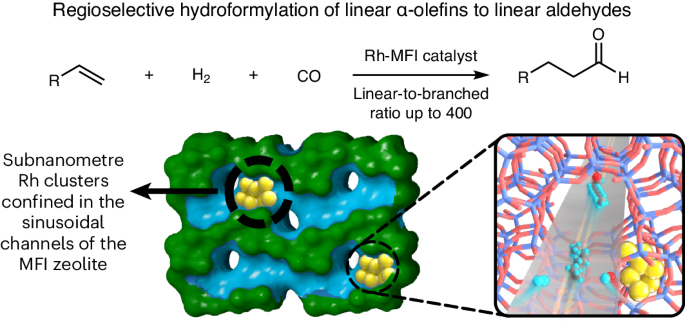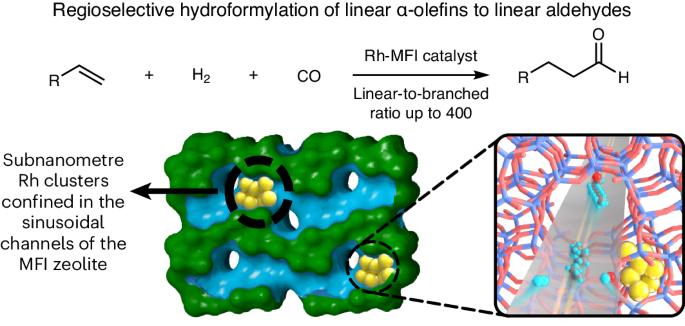Regioselective hydroformylation with subnanometre Rh clusters in MFI zeolite
IF 42.8
1区 化学
Q1 CHEMISTRY, PHYSICAL
引用次数: 0
Abstract
Achieving the regioselective hydroformylation of linear α-olefins to linear aldehydes using solid catalysts with regioselectivities comparable to the corresponding homogeneous process is a great challenge in the chemical industry. Despite the tremendous efforts devoted to this research topic, most of the reported heterogeneous metal catalysts still give considerably lower regioselectivities than well-established homogeneous metal catalysts. Here we show the design of efficient Rh-zeolite catalysts, in which subnanometre Rh clusters are selectively confined in the sinusoidal ten-membered-ring channels of MFI zeolite, for the hydroformylation of long-chain linear α-olefins (C6–C12) into linear aldehydes with very high linear-to-branched aldehyde ratios (up to 400). The exceptional catalytic performances result from the involvement of the MFI zeolite framework as a rigid solid ligand that accommodates subnanometre Rh clusters in the sinusoidal channels of the MFI zeolite. Olefin hydroformylation is traditionally performed with homogeneous catalysts. Here the authors introduce a heterogeneous system based on zeolite-confined Rh clusters that is characterized by high efficiency for the hydroformylation of C6–C12 terminal olefins into linear aldehydes with high selectivity.


用 MFI 沸石中的亚纳米 Rh 簇进行区域选择性加氢甲酰化反应
使用固态催化剂将线性α-烯烃加氢转化为线性醛,并使其具有与相应均相工艺相当的区域选择性,是化学工业面临的一项巨大挑战。尽管人们在这一研究课题上付出了巨大努力,但大多数已报道的异相金属催化剂的区域选择性仍然大大低于成熟的均相金属催化剂。在这里,我们展示了高效 Rh- 沸石催化剂的设计,在这种催化剂中,亚纳米级的 Rh 团簇被选择性地限制在 MFI 沸石的正弦十元环通道中,用于将长链线性 α-烯烃(C6-C12)加氢转化为线性醛,线性醛与支链醛的比例非常高(高达 400)。MFI 沸石框架是一种刚性固体配体,可在 MFI 沸石的正弦通道中容纳亚纳米级的 Rh 团簇,因此具有优异的催化性能。
本文章由计算机程序翻译,如有差异,请以英文原文为准。
求助全文
约1分钟内获得全文
求助全文
来源期刊

Nature Catalysis
Chemical Engineering-Bioengineering
CiteScore
52.10
自引率
1.10%
发文量
140
期刊介绍:
Nature Catalysis serves as a platform for researchers across chemistry and related fields, focusing on homogeneous catalysis, heterogeneous catalysis, and biocatalysts, encompassing both fundamental and applied studies. With a particular emphasis on advancing sustainable industries and processes, the journal provides comprehensive coverage of catalysis research, appealing to scientists, engineers, and researchers in academia and industry.
Maintaining the high standards of the Nature brand, Nature Catalysis boasts a dedicated team of professional editors, rigorous peer-review processes, and swift publication times, ensuring editorial independence and quality. The journal publishes work spanning heterogeneous catalysis, homogeneous catalysis, and biocatalysis, covering areas such as catalytic synthesis, mechanisms, characterization, computational studies, nanoparticle catalysis, electrocatalysis, photocatalysis, environmental catalysis, asymmetric catalysis, and various forms of organocatalysis.
 求助内容:
求助内容: 应助结果提醒方式:
应助结果提醒方式:


